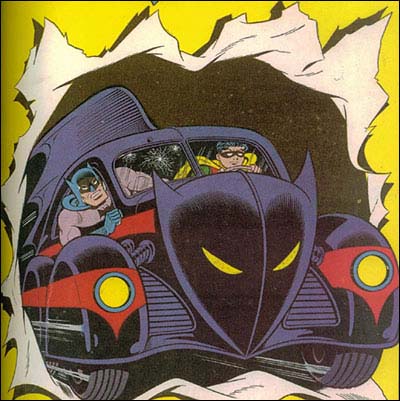Today’s sale of the original TV-show Batmobile reminded me of my slight brush with the history of the various versions of the car.
A kid in the 1950s and ’60s could be a fan of both Superman and Batman, and I was, but Batman had a couple of extra things going for him: he had a cave and he had a cool car. The primary Batmobile of the 1940s was a good-looking unit, and no other comic-book character had anything remotely as cool as this:
In 1950, the editors of the Batman comics decided it was time to update the Batmobile, and this one was born:
This 1950 Batmobile had a crime lab built into the back seat and still had the spooky and amazing front bat-face thingie and the neat swooping rear fin. Not a thing wrong with this baby:
But by the mid-1960s, even I had to admit that 1950s Batmobile, still used in the comic books, was dated-looking.
We had just moved down to Marathon, Florida, and I had time on my hands. So, I decided to create a more modern Batmobile. I chose the front end of a Pontiac of the era and the back end of a Chrysler; combining those was easy; then I added a couple of canopy bubbles like fighter planes had. And, to top it all off, I added a couple of hood and side scoops like Corvettes had. I made sure it had a bat face on the front and two bat-fins on the back!
I drew a really clean version of the design and sent it to Mr. Julius Schwartz, an editor at DC Comics who seemed to encourage kids to become involved in the books.
I promptly forgot about the whole thing until a few months later, when a postcard came from Mr. Schwartz; he always wrote on postcards. He was going to use my Batmobile in the comic books! And– WOW– I would get a free one-year subscription to all the comics he edited. He edited a bunch of good ones, too: Batman, Atom, Green Lantern, Hawkman, Flash, Justice League of America!
Here’s what my version of the Batmobile looked like when it appeared in the comic books:
I was so proud! Then the TV show came out, and the Batmobile on the show made mine look like crap.
Here are a couple of photos of the TV-show Batmobile taken before it even had its glossy paint job; it’s still wearing its flat-black primer:
I was devastated at first, but then figured, “Okay; they have pro guys designing TV-show cars and I’m just a kid! No wonder their’s looks so much better!!!”
One problem was that I could no longer tell my pals I had designed the Batmobile, because the first thing they’d say would be, “THE TV-SHOW ONE?!?!?!” And I’d have to reply, “No; the lame one they use in the comic books and comic strip.”
Eventually– and we’re talking over a year; maybe more– I grew sick of seeing my Batmobile in the books and strips and wrote to Mr. Schwartz again: “Why do you keep using my Batmobile design when the TV-show one is ten times better looking?!?!?!” And a few weeks later, a DC Comics postcard came with his response: “Yours is easier to draw.”
Oh, well. They’ve come out with a 1:43-scale Corgi die-cast version of my Batmobile, which is one of the rarest and costliest Batmobile die-cast models because it is lame-looking compared to the TV-show one and not much sought after. A very generous Batmobile historian and enthusiast in England was nice enough to send me one a couple of years ago; I darn sure wasn’t going to spend over $250 for it on eBay!!! Too bad they used a baby-blue paint for the color:
Yes; I’m proud of my lame creation, but, to me, there is only one Batmobile, and it isn’t the one I dreamed up sitting on the side of my bed in Marathon, Florida, and it isn’t the ones in the comic books and strips and it sure isn’t any of the recent Batman movie Batmobiles; it’s this:

















